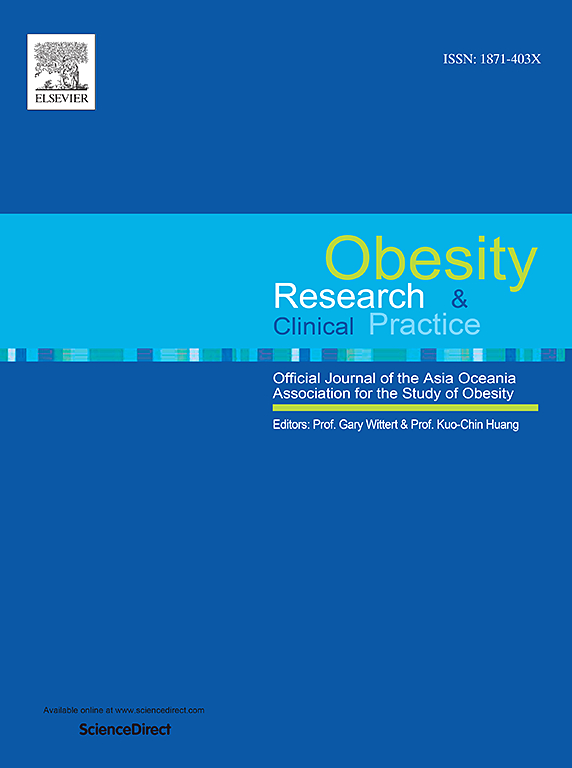Dysregulation of miR-21–5p in children with obesity and its predictive value for metabolic syndrome
IF 2.5
4区 医学
Q3 ENDOCRINOLOGY & METABOLISM
引用次数: 0
Abstract
Background
microRNAs (miRNAs) could mediate the glucose and lipid metabolism progress in metabolic syndrome (MetS).
Objectives
To analyze the value of miRNA (miR)-21–5p for MetS diagnosis in children with obesity. Function of miR-21–5p has been explored by the prediction of target genes and functional and pathway enrichment analysis.
Methods
Relative miR-21–5p level was examined by qRT-PCR. Predictive value of miR-21–5p for MetS was assessed by ROC curve. miRBase, TargetScan, and miRWalk databases were used to screen the target genes of miR-21–5p. GO and KEGG were operated to analyze the function of candidate genes of miR-21–5p.
Results
Overexpressed miR-21–5p was discovered in MetS children (P < 0.001). High miR-21–5p level could predict MetS patients from children with obesity. Serum miR-21–5p level was closely related to BMI (r = 0.631, P < 0.001), FBG (r = 0.341, P < 0.001), Fasting Insulin (r = 0.438, P < 0.001), TG (r = 0.662, P < 0.001), SBP (r = 0.432, P < 0.001), DBP (r = 0.524, P < 0.001), and HDL-C (r = -0.201, P < 0.001). High miR-21–5p level could predict MetS patients from children with obesity (AUC= 0.827, sensitivity= 0.750, specificity=0.806, cutoff value= 1.0293, P < 0.001). Venn diagram found 83 intersection genes among 3 databases. GO and KEGG analyses indicated that candidate genes of miR-21–5p were mainly correlated with Axon guidance, FoxO signaling pathway, cytokine-cytokine receptor interaction, and insulin resistance pathways.
Conclusion
Blood miR-21–5p was elevated in MetS children, and could predict MetS subjects from children with obesity. miR-21–5p could regulate the MetS development via FoxO signaling pathway and insulin resistance pathways.
肥胖儿童miR-21-5p异常及其对代谢综合征的预测价值
背景:microRNAs (miRNAs)可以介导代谢综合征(MetS)的糖脂代谢过程。目的:分析miRNA (miR)-21-5p在肥胖儿童met诊断中的价值。miR-21-5p的功能已经通过靶基因的预测和功能及通路富集分析来探索。方法:采用qRT-PCR检测miR-21-5p的相对水平。采用ROC曲线评估miR-21-5p对MetS的预测价值。使用miRBase、TargetScan和miRWalk数据库筛选miR-21-5p的靶基因。通过GO和KEGG分析miR-21-5p候选基因的功能。结果:在MetS儿童中发现了miR-21-5p过表达(P 结论:MetS儿童血miR-21-5p升高,可以预测肥胖儿童的MetS受试者。miR-21-5p可通过FoxO信号通路和胰岛素抵抗通路调控MetS的发展。
本文章由计算机程序翻译,如有差异,请以英文原文为准。
求助全文
约1分钟内获得全文
求助全文
来源期刊

Obesity research & clinical practice
医学-内分泌学与代谢
CiteScore
7.10
自引率
0.00%
发文量
80
审稿时长
49 days
期刊介绍:
The aim of Obesity Research & Clinical Practice (ORCP) is to publish high quality clinical and basic research relating to the epidemiology, mechanism, complications and treatment of obesity and the complication of obesity. Studies relating to the Asia Oceania region are particularly welcome, given the increasing burden of obesity in Asia Pacific, compounded by specific regional population-based and genetic issues, and the devastating personal and economic consequences. The journal aims to expose health care practitioners, clinical researchers, basic scientists, epidemiologists, and public health officials in the region to all areas of obesity research and practice. In addition to original research the ORCP publishes reviews, patient reports, short communications, and letters to the editor (including comments on published papers). The proceedings and abstracts of the Annual Meeting of the Asia Oceania Association for the Study of Obesity is published as a supplement each year.
 求助内容:
求助内容: 应助结果提醒方式:
应助结果提醒方式:


